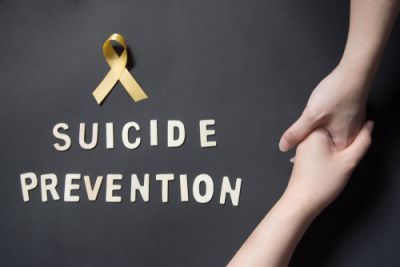 The American Foundation for Suicide Prevention reports that suicide is the 10th leading cause of death in the U.S. On average, there are about 123 suicides per day. Consider that AFSP estimates there are 25 attempts for every death. Men die by suicide at a much higher rate than women. The rate of suicide is highest for white men in their middle ages, but suicide is not limited to any race, age or ethnicity.
The American Foundation for Suicide Prevention reports that suicide is the 10th leading cause of death in the U.S. On average, there are about 123 suicides per day. Consider that AFSP estimates there are 25 attempts for every death. Men die by suicide at a much higher rate than women. The rate of suicide is highest for white men in their middle ages, but suicide is not limited to any race, age or ethnicity.
September is National Suicide Prevention Month. When you know someone who is struggling with emotions, it can be hard to know what to do. There are many helplines available for both you and your loved one. It’s scary to deal with a friend who is thinking about suicide. You’re not alone.
Recognize the Warning Signs
If a loved one starts talking about suicide, that’s a pretty clear sign that he or she might be considering it. But there are other warning signs that can indicate a person is thinking about suicide. Here are things to be aware of:
- A person may be looking for a way to die, such as buying a gun or searching online for ideas.
- Your friend might talk about having no reason to live, feeling hopeless or trapped or being a burden to others.
- You may notice an increased usage of alcohol or drugs.
- Your loved one might withdraw and become isolated.
- You may see that your friend has extreme mood swings or talks about revenge.
What Can You Do?
The National Suicide Prevention Lifeline created five action steps for communicating with a person who might be suicidal. You can call 1-800-273-TALK (8255) or go to www.bethe1to.com to get more information about suicide prevention.
Step 1: Ask
Being non-judgmental and supportive can often open the door to effective dialogue about suicide. Asking questions, such as “how can I help you?” or “are you thinking about suicide?” can help you get information about what steps you and your loved one can take. Use active listening skills to talk about suicide. Studies show that acknowledging suicidal thoughts does not increase the risk of suicide. It can actually reduce suicidal ideation.
Step 2: Keep Them Safe
Establish safety. Once you know that your loved one is talking about suicide, you need to consider whether he or she has a plan and how imminent the danger is. A person who is thinking about suicide needs help. But when a person has access to medication or firearms and has thought about a particular method, the risk is more imminent. You may need to help put time and distance between your loved one and his or her chosen plan.
Step 3: Be There
In this step, you show support. You might do this by physically being present, but you could also help find resources that connect your loved one to others who can help. Don’t commit to something that you can’t accomplish. Make sure you can follow through with your support.
Step 4: Help Your Loved One Connect
You can encourage your loved one to call the Lifeline or connect the person to mental health resources in the community. Another way to help is to work with your loved one to develop a safety plan. What can your loved one do when significant thoughts of suicide occur? Making one call to a helpline can reduce suicide risk. Regular, ongoing, professional help can be instrumental in suicide prevention.
Step 5: Follow Up
Check in with your loved one once the crisis is over. Studies show that ongoing contact is important in suicide prevention. A short text or written note can be very uplifting when someone is recovering from mental health issues.
Remember, help is available. You’re not alone. Suicide is a difficult topic. The only way to reduce the stigma is to talk about it.



